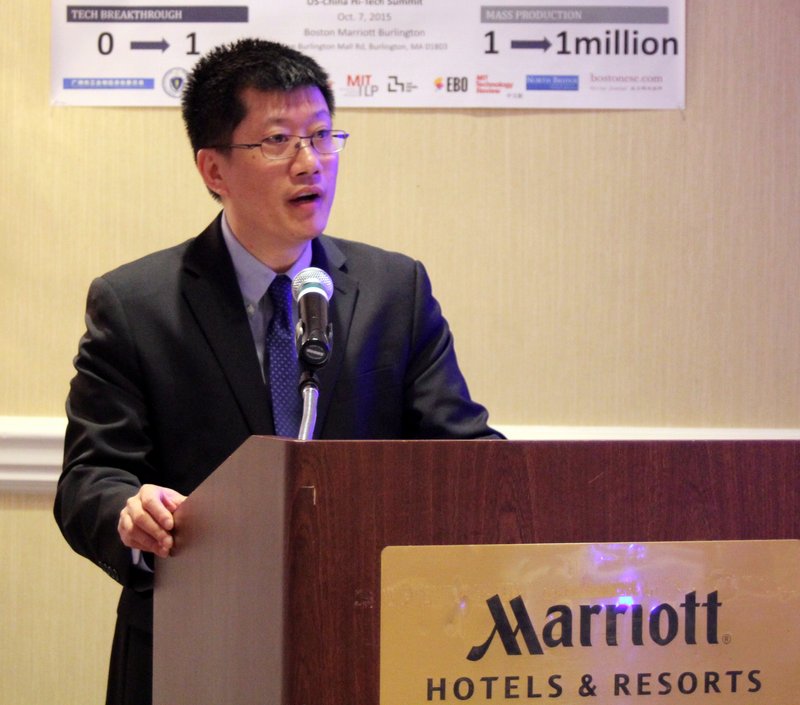By Xue Zhaofeng , speech at US-China Hi-Tech Summit, Boston 2015
I’m pleased to give some remarks on behalf of Peking University Business School’s (BiMBA) “Modular Innovation and China’s Opportunities” delegation. Our members are mostly from the EMBA alumni of Peking University Business School (BIMBA). All of them are excellent leaders from the investment and industry fields. Our trip to the United States is to search for the origins of innovation, and to explore new technologies, new business models, and new business opportunities.

In the past 10 days, we traveled across the US from the West Coast to the East Coast, visiting the edgy innovative enterprises, including LightSail, which stores energy via compressed air; Terrafugia, which produces flying cars; MC10, which focuses on research and development of soft electronics; Mass Innovation Club, which produces edgy biological and chemical ideas; WiTricity, which develops R&D of wireless charging technology, and so on. Moreover, we also visited the world’s largest equity crowdfunding platform, AngelList, and listened to the MegaTrend forecast from the world’s largest analytic consulting company, Frost & Sullivan.
We believe that today there has been a spurt of innovative activities in the United States, which cover various fields of energy, aerospace, robotics, electronics, health care, and education. We can describe the innovation process as “Modular Innovation”; it contains two layers of meaning.
First, the horizontal dimension is based on a combination of the elements required for innovative activities. An innovative product, like a space shuttle, needs power design, exterior design, dashboard design, substance design, financing pattern design, and so on. These elements constitute not only a product, but an ecology, of which each is the best, but also very narrow. By putting them together, it becomes a world-class product, which is the horizontal dimension of “Modular Innovation.”
Second, the vertical dimension is a combination of decision-making power in all stages of innovative development. From a series of concepts to technology, financing, manufacturing and marketing, different roles provide different professional knowledge, and have different amounts of discretionary power. The earliest scientists have greater discretionary power, followed by venture capitalists, then manufacturers and distributors. In the course of this progressive process, the profit scale gradually becomes clear, and the distribution of different roles gradually nail down. This is the vertical dimension of “Modular Innovation”
Over the past 30 years, China’s economy has experienced rapid growth. This is mainly due to the reform of property rights, price deregulation, joining the WTO, and exchange rate policy, as well as regional competition and other powerful driving forces. Today, however, economic growth has slowed, and will continue to slow down. This is due to the disappearance of the demographic dividend, negative influences of the labor law, as well as poor governance of state-owned enterprises. To get rid of this trend, we must find a major breakthrough. These breakthroughs are included in the wave of modular innovation. We should search for and seize opportunities in China.
We have seen that the chain of “inventing and creating → patent right confirming → capital screening → producing and manufacturing → global marketing” has been opened up. The fine division and seamless connections on the chain have led to the forming of a new patter of “modular innovation”. We believe that the Chinese government, business, and academia should seize these opportunities, aiming at “manufacturing” and “global marketing,” and make efforts on aspects below:
First, [the information level]–establish a world-leading technology research think tank, and strengthen the link between the think tank and manufacturing. Then, we must seize the opportunity to transform the latest international inventions into commercial applications in time; encourage China-US communication, hold visiting fairs between innovative US investors and Chinese manufacturing, enhance understanding and information updates, effectively promote the complementation and joint projects between the two countries in a cycle of innovation and entrepreneurship. Specific practices include cooperation with agencies like domestic think tanks and Frost & Sullivan / University Technology workers associations (AUTM).
Second, [the legal level]–on a large scale, introduce an intellectual property disputes arbitration mechanism which has been proved to be effective or has been universally adhered to from the United States and other developed countries. This would reduce the cost of learning and transactions of US innovative enterprises on the relevant technical regulations, and quickly eliminating the American innovative enterprises’ worries about disclosure of business secrets after technology imports and mass production in China.
Third, [project selection and financing levels]–build IP transactions docking platforms with relevant authorities in the U.S. and other developed countries in order to help Chinese entrepreneurs to accurately and effectively inquire, verify, discover and screen patents with potential commercial value. This, therefore, would help overcome the severe universal innovative high-tech industry barriers in information asymmetry, reducing huge losses caused by false judgments, eliminating technical, commercial and legal risks that exist in importing talents and technology in China. In particular, it is possible to cooperate with AngelList, and establish an international crowdfunding platform, and satisfy the needs of intellectual property transactions and financing at one time.
Fourth, [strategic cooperation level] Instead of the previous conservative mode of Chinese entrepreneurs’ “financial investment” on innovative American enterprises, and change to “strategic investment” on industrial scale matching in order to take full advantage of China’s manufacturing industry and promote industry reconstruction and update on product manufacturing in the future.
During this short 10 days of visit, we are encouraged. We hope to see the two countries work together and build a platform for dialogue and cooperation, and win huge benefits from “modular innovation” together.